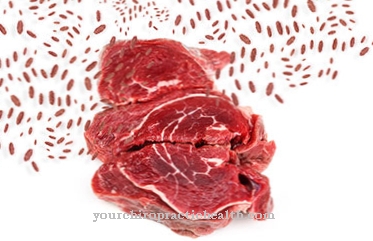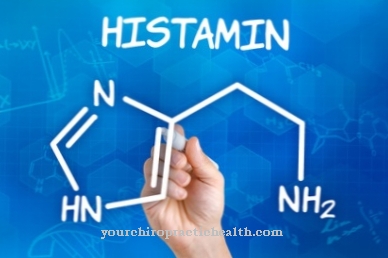The Vitreous bone disease or. Osteogenesis imperfecta is a genetic disease in which the collagen balance is disturbed and as a result the bones easily break and deform. The course of vitreous bone disease depends on the type of gene damage.
What is Glass Bone Disease?
.jpg)
© heidepinkall - stock.adobe.com
Glass bone disease is an inherited disease in which collagen formation in the body is impaired. Collagen is important for the formation of bones. But it is also found in ligaments and tendons, in the conjunctiva of the eye and in the teeth.
Osteogenesis imperfecta means something like "incomplete bone formation". Normally, the bones of the human skeleton are made up of collagen rods, which in turn are made up of collagen fibers, and minerals. Both together ensure both stability and elasticity of the bones.
In vitreous bone disease, either there is not enough collagen or the collagen fibers form abnormally shaped collagen rods. This changes the structure of the bones; they are no longer stable enough and break like glass, which has given rise to the colloquial term glass bone disease. Originally, four different types of the disease were assumed, but three more have now been discovered, so that today there are 7 types of vitreous bone disease.
causes
The cause of glass bone disease is a mutation (change) in the gene that is responsible for the production of collagen. Through this genetic defect, a defective messenger substance is transmitted to the body cells, which then produce incomplete or modified collagen fibers.
This results in deformed or broken collagen rods that are unable to give the bone the necessary stability. The severity of the disease depends on the extent of the defects on the collagen rods.
But there are also types of glass bone disease in which perfectly normal collagen rods are produced, but their number is far too small to be able to stabilize the bones. Symptoms for this type of vitreous bone disease are mild.
Symptoms, ailments & signs
The symptoms of osteogenesis imperfecta depend heavily on the type of disease. Type 2 patients are most severely affected, where the disease is usually fatal at a young age. The popular term “glass bone disease” describes the characteristic features of those affected quite aptly. The inadequate bone formation leads to excessive fractures.
Even slight impacts or greater stress on the bones can lead to fractures. These breaks are then called spontaneous or fatigue breaks. This leads to deformities of the skull, short stature and deformations of the spine (for example scoliosis). This insufficient bone formation can also be shown in the X-ray image.
The bones allow more X-rays to pass through and the bones appear darker in the X-ray image. Doctors refer to this phenomenon as increased radiation transparency of the bones. The teeth can also be affected by the increased fragility. The other symptoms of the hereditary disease are very complex.
They include hearing loss, weak muscles and hyperextensible joints, tinnitus, myopia and increased sweating. Outwardly conspicuous, especially in type 1 osteogenesis imperfecta, are the blue sclera. The normally visible white of the eye is called sclera.
Diagnosis & course
The course of vitreous bone disease varies depending on the underlying type of genetic defect. The diagnosis is usually made on the basis of the symptoms and confirmed with an X-ray examination.
On x-rays, healthy bone looks white, while less dense bone mass appears more translucent. The bends and healed old fractures caused by the glass bone disease can also be clearly seen on an X-ray. The disease progresses differently depending on the type.
Type 1 is the most common and mildest, while type 2 is the most severe. Type 2 sufferers do not have a long life expectancy and often do not survive childbirth. The typical symptoms of vitreous bone disease are fractures and deformities of the bones. The sclera (the dermis = the white of the eye) can be shaded bluish, reddish or gray.
The physique can be largely normal, as in type 1, for example, but severe curvatures of the spine or short stature can also occur (type 4). Teeth are often brittle and hearing deteriorates in adolescence. Underdeveloped lungs and associated breathing problems are also common in vitreous bone disease.
Complications
In the case of osteogenesis imperfecta, the patient's quality of life is severely impaired. The everyday life of the person concerned is usually associated with severe pain and restrictions. It is not uncommon for this to lead to depression and other psychological moods that can be treated by a psychologist. The bones break easily and are also easily deformed.
The patients often suffer from short stature and very often from bruises on the skin. The spine can also be affected by osteogenesis imperfecta. Most of those affected also suffer from respiratory problems, which can lead to a reduced oxygen supply. It is not uncommon for children in particular to become victims of bullying or teasing as a result of the symptoms, which can also lead to depression or inferiority complexes.
The relatives and parents of the children can also be affected by depressive moods. A causal treatment of osteogenesis imperfecta is not possible. For this reason, only the symptoms are usually limited. However, the person affected has to forego risks and certain types of sports and thus suffers from severe restrictions in life. The pain can also be limited with the help of therapies. There are no further complications.
When should you go to the doctor?
A doctor's visit is necessary as soon as there are irregularities in the body structure. If there are deformations, unusual bone positions or short stature, a doctor should be consulted. Children who show little growth in direct comparison to their peers or who can unnaturally overextend their joints should be presented to a doctor for a check-up. If there are visible deformations of the spine, this observation should be discussed with a doctor.
If the person's bones break very quickly, a doctor is needed. If the fractures occur after a slight fall or bruise, this is considered unusual.The processes must be carefully observed and clarified with a doctor as soon as possible in order to avoid further complications.
If the person concerned suffers from frequent bruising or bruising, a doctor should be consulted. A doctor is required in the event of breathing problems, white skin on the eyes and noticeable weakness of the connective tissue. If a diagnosed vitreous bone disease leads to psychological problems, a doctor's visit is also necessary.
The patient needs emotional help in everyday life in order to be able to deal with the disease and its consequences. A doctor should therefore be visited in the event of behavioral problems or changes in personality. If you are withdrawn from society, in a melancholy or depressed mood, or if you have aggressive tendencies, you should speak to a doctor.
Doctors & therapists in your area
Treatment & Therapy
Glass bone disease is a lifelong disease. Since it is caused by a genetic defect, it cannot be cured. Sufferers are advised to arrange their lives in such a way that their bones are not additionally stressed or damaged. This means that they should eat healthily, drink nicotine and alcohol only in moderation, and watch their weight.
Even if there is no curative therapy, it is important to recognize the disease early for the further course. If the symptoms are treated at an early stage, complications can be prevented and at least some symptoms can be alleviated. There are currently three common routes of treatment. One way is to give bisphosphonates. This is a substance that is deposited in the bone and inhibits the breakdown of bone material.
Another treatment option for vitreous bone disease is intramedullary nailing. Metal rods are inserted into the interior of the longitudinal bones in a surgical procedure. These act like splints, they stabilize the bones and prevent breaks and deformations. Another treatment is physiotherapy, with the aim of strengthening the muscles so that they can support the bones.
The training is usually carried out in the water, as there is no risk of falling and patients can move around easily. However, the success of the treatments also depends on the type of vitreous bone disease.
Outlook & forecast
People with osteogenesis imperfecta have a genetic defect. For this reason there is no cure. Medical interventions and modern therapy options have significantly improved living conditions for those affected. However, many of them experience physical pain and mental discomfort throughout their lives.
The prognosis and course of the vitreous bone disease depend on the type and aggressiveness of the disease. In severe cases, life expectancy is significantly reduced. Patients with type 1 vitreous bone disease usually have a good prognosis. In them, bone fractures decrease significantly after puberty, although they become more common in women affected during menopause. It is mostly possible for them to pursue a regular life and to work in a sitting position.
If type 2 or type 3 is present, the prognosis is much worse. People with osteogenesis imperfecta type 3 die very early. Some of them do not survive birth and die in the womb. Many affected children die of cerebral haemorrhage or breathing difficulties due to numerous bone fractures within the first days of life. Type 3 has a poor prognosis. The patients are mostly dependent on the wheelchair. Many of them get breathing problems.
prevention
There is currently no preventive action against vitreous bone disease, as it is genetic. It is important to start treatment early to avoid complications and a severe course.
Aftercare
Follow-up care for a vitreous bone disease is extremely important. The person affected should make sure that they do not lift too heavily and avoid demanding activities. The bones are very sensitive and especially in the initial stage of follow-up care should be given to the body. It is important that the instructions of the attending physician are strictly followed.
The medication intake must not be discontinued if improvement occurs. To avoid further fractures, these guidelines should be followed in any case. Light gymnastics exercises also help strengthen the bones. Also, swimming is a good activity for strengthening the weak body in a good way. Another important factor is the intake of essential vitamins and minerals.
The intake of vitamins such as vitamin B12, vitamin C or zinc can support bone strengthening. The diet itself should be varied and healthy. Many of those affected do not know how important a balanced diet is for their bones and neglect it with fatal consequences. If these helpful aftercare options are adhered to by the affected person, the symptoms are guaranteed to be alleviated.
You can do that yourself
Glass bone disease is a disease that is caused by a genetic defect. This disease is incurable and self-help measures are limited accordingly.
Due to the very high risk of injury in patients suffering from such a disease, care must be taken to protect the body. Physical exertion is strongly discouraged. Those affected must also ensure that they do not get injured in everyday life. Bumping into a piece of furniture can already lead to a broken bone.
Most of the time, patients need help from family members or nursing staff to help them cope with everyday life. This is also important as those affected are often dependent on a wheelchair.
Those affected are severely restricted in their lives. This can lead to psychological problems and also depression. Psychological treatment of patients suffering from vitreous bone disease is therefore of great importance so that the patients learn to deal with their situation.
Participation in a self-help group on the subject of glass bone disease can also act as emotional support for those affected. The exchange with other affected people gives them the feeling that they are not alone with this situation and they can learn more about how others cope with their everyday lives.



.jpg)
.jpg)






















